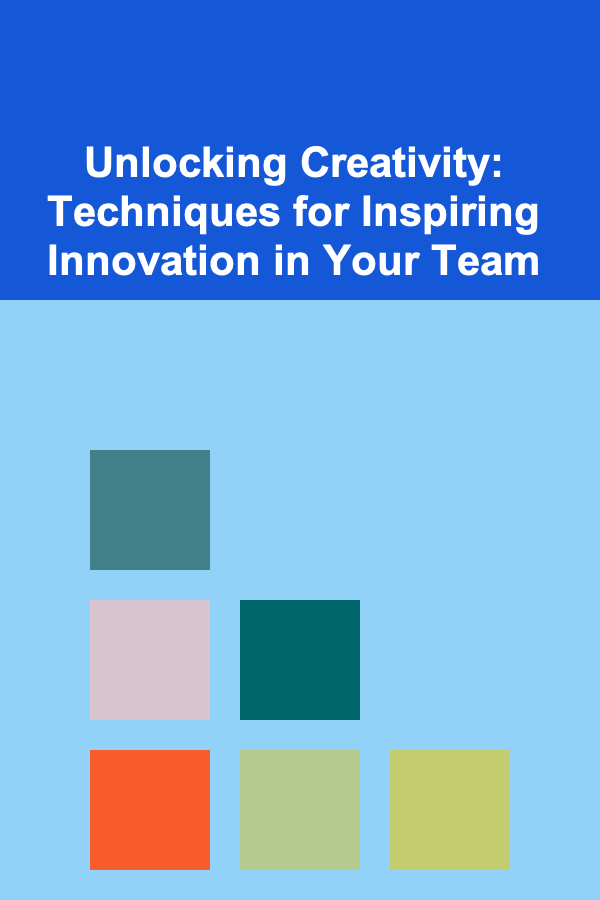
Unlocking Creativity: Techniques for Inspiring Innovation in Your Team
ebook include PDF & Audio bundle (Micro Guide)
$12.99$7.99
Limited Time Offer! Order within the next:

Creativity is the lifeblood of innovation. In a world that is constantly evolving, organizations must cultivate an environment that nurtures creative thinking and problem-solving. But fostering creativity within a team can often be a challenge. It requires more than just providing the right tools; it requires a mindset shift and a supportive culture. In this actionable guide, we will explore techniques to unlock creativity in your team, helping them think outside the box, tackle problems innovatively, and push the boundaries of what's possible.
Create a Safe Space for Ideas
The first step to encouraging creativity is creating a safe environment where ideas can flow freely. When team members feel judged or that their ideas are not valued, they are less likely to speak up or take risks. Establishing a culture of psychological safety is essential.
How to do this:
- Encourage Open Communication: Let everyone know their input is welcomed, regardless of their role or seniority. Regularly remind your team that all ideas, even seemingly "wild" ones, are worth considering.
- Celebrate Mistakes as Learning Opportunities: Innovation involves trial and error. When someone makes a mistake, focus on the lessons learned and how those lessons can lead to better solutions in the future.
- Facilitate Brainstorming Sessions: Create a non-critical brainstorming environment where everyone can freely contribute ideas. Use techniques such as "yes, and" (inspired by improvisation) to encourage building upon others' ideas without judgment.
Diversify the Team
One of the most effective ways to foster innovation is by having a diverse team. Different backgrounds, perspectives, and experiences bring new insights and ways of thinking. Diversity in terms of gender, race, expertise, and thinking styles can spark creativity in surprising ways.
How to do this:
- Mix Different Departments and Skillsets: Cross-functional teams bring together a variety of expertise that may not otherwise interact. For example, combining marketing, design, and engineering experts can lead to creative breakthroughs.
- Encourage Collaboration with External Experts: Sometimes, the most innovative solutions come from people outside your team or organization. Invite guest speakers or consultants to provide fresh perspectives and ideas.
- Foster an Inclusive Environment: Ensure that everyone feels heard and valued. Implement inclusive leadership practices and encourage collaboration between diverse team members.
Set Clear, Inspiring Goals
While it may seem counterintuitive, constraints can often fuel creativity. When teams know the "why" behind their work and the impact they aim to achieve, they can channel their creativity in more focused and effective ways. Goals should be both challenging and meaningful, giving the team a sense of purpose.
How to do this:
- Use the SMART Goal Framework: Set Specific, Measurable, Achievable, Relevant, and Time-bound goals to provide structure while encouraging innovative approaches to achieving them.
- Tie Goals to a Larger Vision: Help your team see the broader mission behind the task. When the purpose is clear and exciting, team members will be more motivated to push creative boundaries to achieve it.
- Provide Autonomy within Structure: Allow team members the freedom to choose how they approach solving a problem, within the confines of the goal. Autonomy fosters ownership and innovation.
Encourage Cross-Pollination of Ideas
Innovation thrives when different ideas from various domains intersect. Cross-pollination happens when individuals from different areas of expertise collaborate and share knowledge. By encouraging diverse thinking and collaboration, you can generate new concepts that might not have been possible within siloed thinking.
How to do this:
- Create Collaborative Spaces: Whether physical or virtual, spaces designed for brainstorming and idea exchange help team members to easily collaborate. Break down the barriers between departments or teams to encourage free-flowing dialogue.
- Use Idea Management Tools: Digital platforms where employees can submit and vote on ideas, such as an idea board or innovation platform, can help surface valuable insights and foster a culture of innovation.
- Host Idea Competitions: Set up internal competitions where teams pitch creative ideas to solve a particular problem. This not only generates new ideas but also motivates the team to think more innovatively.
Provide Time and Space for Creative Exploration
Creativity often flourishes when there is space for free thought and exploration. When teams are constantly under pressure to meet deadlines and perform at a high level, the ability to think creatively can be stifled. It's essential to allow your team time to step back, relax, and recharge.
How to do this:
- Implement "Innovation Days": Allocate certain days where employees can work on side projects, explore new ideas, or experiment with different approaches outside their usual responsibilities. This can be a designated day once a month or a quarterly initiative.
- Promote Downtime and Reflection: Encourage team members to take breaks and spend time away from their workstations. Research shows that breaks and time away from tasks help to refresh the mind and spark new ideas.
- Encourage a "Fail Fast" Mentality: In a fast-paced environment, experimenting with ideas and quickly identifying what doesn't work can be just as valuable as discovering what does. This mindset encourages innovation and reduces the fear of failure.
Leverage Technology for Idea Generation
In today's digital age, technology can play a critical role in unlocking creativity. Tools that streamline idea generation, enhance collaboration, and improve brainstorming can significantly impact the creative process.
How to do this:
- Use Collaborative Tools: Platforms like Slack, Microsoft Teams, or Trello can make communication and collaboration more seamless, allowing team members to share ideas and feedback instantly.
- Experiment with Creativity Software: Tools like Miro, MindMeister, and Canva can help visualize ideas, create prototypes, and map out concepts more effectively. These tools allow teams to collaborate in real time, especially in remote or hybrid work environments.
- Encourage Gamification: Introduce game mechanics into brainstorming or idea-generation sessions. For example, use idea-pitching games, point systems, or challenges to inspire friendly competition and out-of-the-box thinking.
Recognize and Reward Creativity
Creativity should be recognized and celebrated. When team members see that creative thinking is valued and rewarded, they are more likely to continue innovating and pushing boundaries.
How to do this:
- Celebrate Small Wins: Acknowledge even the smallest creative victories, whether it's a new approach to a problem or a breakthrough idea. Recognition helps build momentum and encourages others to contribute.
- Offer Incentives for Innovation: Create reward systems for those who come up with the most innovative ideas or successfully implement creative solutions. This could be financial rewards, public recognition, or additional professional opportunities.
- Share Success Stories: Highlight instances where creative thinking led to tangible results. Whether it's through team meetings or internal newsletters, showcasing how creativity contributes to success can motivate others to think innovatively.
Lead by Example
As a leader, your behavior sets the tone for the team. If you want your team to be innovative and creative, you need to model those behaviors yourself. Be open to new ideas, embrace experimentation, and take calculated risks.
How to do this:
- Be Transparent About Challenges: Share your own creative processes and struggles with the team. Being open about challenges can inspire others to think critically and experiment with their own ideas.
- Foster a Growth Mindset: Encourage learning and development, both individually and as a team. Emphasize that creativity is a skill that can be nurtured through practice and continuous improvement.
- Be Open to Feedback: Show that you value input from all levels of the team, and encourage constructive criticism. A culture of mutual respect and feedback fosters creativity and innovation.
Conclusion
Unlocking creativity within a team isn't about imposing rigid structures or rules---it's about cultivating an environment where ideas can flourish naturally. By creating a safe space, diversifying the team, setting clear and inspiring goals, and fostering collaboration, you can ignite a culture of innovation that leads to meaningful breakthroughs. Encourage exploration, leverage technology, and always recognize the value of creative thinking. Most importantly, lead by example, showing your team that creativity is not just a process---it's a mindset that can drive long-term success.
Reading More From Our Other Websites
- [Gardening 101] The Science Behind Organic Pest Deterrents: What Really Works?
- [Personal Care Tips 101] How to Choose a Makeup Primer for Minimizing Large Pores
- [Hiking with Kids Tip 101] Desert Trail Treasures: Kid‑Friendly Hikes and Hidden Wonders
- [Organization Tip 101] How to Organize Your Sewing Room for Seamless Projects
- [Personal Financial Planning 101] How to Prepare for Tax Season Throughout the Year
- [Home Budget Decorating 101] How to Mix Patterns and Textures on a Budget
- [Horseback Riding Tip 101] Step-by-Step Guide: Properly Saddling Your Horse for Beginners
- [Home Party Planning 101] How to Create a Cozy Atmosphere for an Indoor Winter Party
- [Mindful Eating Tip 101] Best Mindful Eating Rituals for Managing Chronic Pain and Inflammation
- [Home Soundproofing 101] How to Soundproof Your Floor for Ultimate Privacy

How to Clean Your Air Ducts for Better Indoor Air Quality
Read More
How to Involve Kids in Organizing Their School Supplies
Read More
How to Use Deep Learning to Profit from Data Science Projects
Read More
How to Use Magnetic Recipe Holders for Space-Saving
Read More
How to Use Mind Mapping for Paperwork Organization
Read More
Dyeing with Nature: A Comprehensive Guide to Natural Dyes
Read MoreOther Products

How to Clean Your Air Ducts for Better Indoor Air Quality
Read More
How to Involve Kids in Organizing Their School Supplies
Read More
How to Use Deep Learning to Profit from Data Science Projects
Read More
How to Use Magnetic Recipe Holders for Space-Saving
Read More
How to Use Mind Mapping for Paperwork Organization
Read More